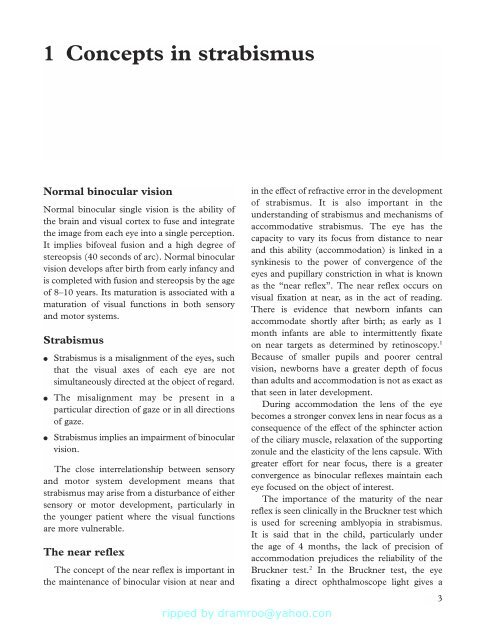Strabismus - Fundamentals of Clinical Ophthalmology.pdf
Strabismus - Fundamentals of Clinical Ophthalmology.pdf
Strabismus - Fundamentals of Clinical Ophthalmology.pdf
Create successful ePaper yourself
Turn your PDF publications into a flip-book with our unique Google optimized e-Paper software.
1 Concepts in strabismus<br />
Normal binocular vision<br />
Normal binocular single vision is the ability <strong>of</strong><br />
the brain and visual cortex to fuse and integrate<br />
the image from each eye into a single perception.<br />
It implies bifoveal fusion and a high degree <strong>of</strong><br />
stereopsis (40 seconds <strong>of</strong> arc). Normal binocular<br />
vision develops after birth from early infancy and<br />
is completed with fusion and stereopsis by the age<br />
<strong>of</strong> 8–10 years. Its maturation is associated with a<br />
maturation <strong>of</strong> visual functions in both sensory<br />
and motor systems.<br />
<strong>Strabismus</strong><br />
●<br />
●<br />
●<br />
<strong>Strabismus</strong> is a misalignment <strong>of</strong> the eyes, such<br />
that the visual axes <strong>of</strong> each eye are not<br />
simultaneously directed at the object <strong>of</strong> regard.<br />
The misalignment may be present in a<br />
particular direction <strong>of</strong> gaze or in all directions<br />
<strong>of</strong> gaze.<br />
<strong>Strabismus</strong> implies an impairment <strong>of</strong> binocular<br />
vision.<br />
The close interrelationship between sensory<br />
and motor system development means that<br />
strabismus may arise from a disturbance <strong>of</strong> either<br />
sensory or motor development, particularly in<br />
the younger patient where the visual functions<br />
are more vulnerable.<br />
The near reflex<br />
The concept <strong>of</strong> the near reflex is important in<br />
the maintenance <strong>of</strong> binocular vision at near and<br />
in the effect <strong>of</strong> refractive error in the development<br />
<strong>of</strong> strabismus. It is also important in the<br />
understanding <strong>of</strong> strabismus and mechanisms <strong>of</strong><br />
accommodative strabismus. The eye has the<br />
capacity to vary its focus from distance to near<br />
and this ability (accommodation) is linked in a<br />
synkinesis to the power <strong>of</strong> convergence <strong>of</strong> the<br />
eyes and pupillary constriction in what is known<br />
as the “near reflex”. The near reflex occurs on<br />
visual fixation at near, as in the act <strong>of</strong> reading.<br />
There is evidence that newborn infants can<br />
accommodate shortly after birth; as early as 1<br />
month infants are able to intermittently fixate<br />
on near targets as determined by retinoscopy. 1<br />
Because <strong>of</strong> smaller pupils and poorer central<br />
vision, newborns have a greater depth <strong>of</strong> focus<br />
than adults and accommodation is not as exact as<br />
that seen in later development.<br />
During accommodation the lens <strong>of</strong> the eye<br />
becomes a stronger convex lens in near focus as a<br />
consequence <strong>of</strong> the effect <strong>of</strong> the sphincter action<br />
<strong>of</strong> the ciliary muscle, relaxation <strong>of</strong> the supporting<br />
zonule and the elasticity <strong>of</strong> the lens capsule. With<br />
greater effort for near focus, there is a greater<br />
convergence as binocular reflexes maintain each<br />
eye focused on the object <strong>of</strong> interest.<br />
The importance <strong>of</strong> the maturity <strong>of</strong> the near<br />
reflex is seen clinically in the Bruckner test which<br />
is used for screening amblyopia in strabismus.<br />
It is said that in the child, particularly under<br />
the age <strong>of</strong> 4 months, the lack <strong>of</strong> precision <strong>of</strong><br />
accommodation prejudices the reliability <strong>of</strong> the<br />
Bruckner test. 2 In the Bruckner test, the eye<br />
fixating a direct ophthalmoscope light gives a<br />
3










![SISTEM SENSORY [Compatibility Mode].pdf](https://img.yumpu.com/20667975/1/190x245/sistem-sensory-compatibility-modepdf.jpg?quality=85)





